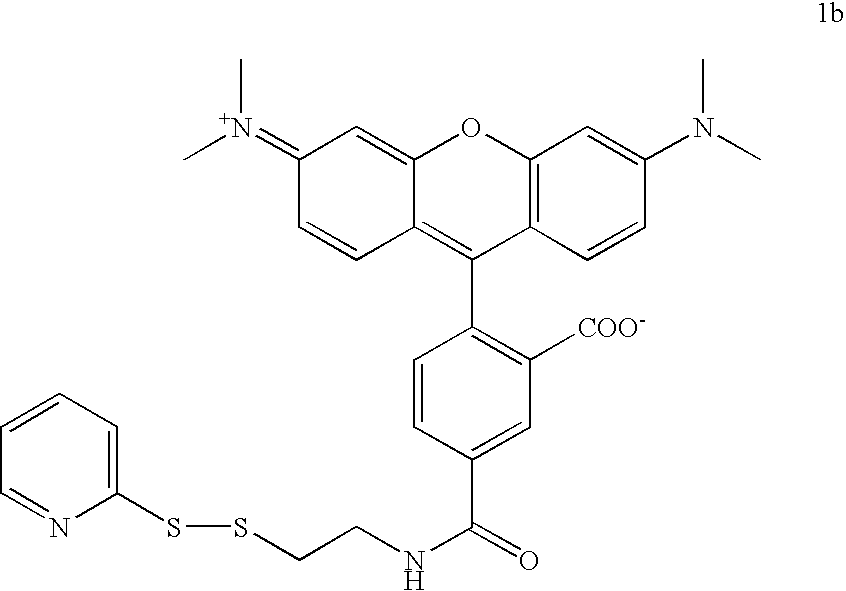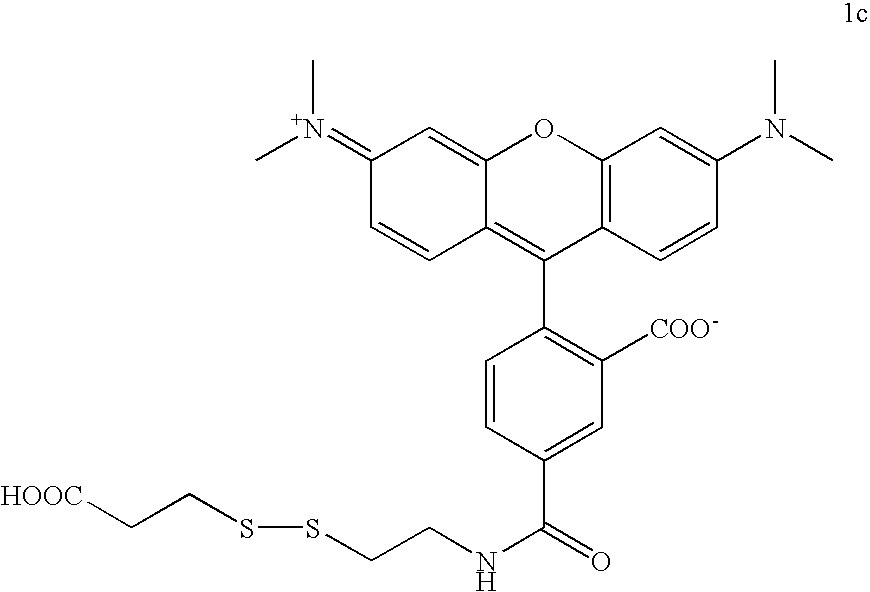Labelled nucleotides
a technology of labelled nucleotides and nucleotides, which is applied in the field of labelled nucleotides, can solve the problems that nucleotides are difficult to incorporate into existing polynucleotides,
- Summary
- Abstract
- Description
- Claims
- Application Information
AI Technical Summary
Benefits of technology
Problems solved by technology
Method used
Image
Examples
example 1
Synthesis of Disulfide Linker
[0080]
[0081] tButyl-N-(2-mercaptoethyl) carbamate (3 mmol, 0.5 mL) was added dropwise to a solution of 1.32 g (6.0 mmol) aldrithiol in 15 mL MeOH. After 1.5 h the reaction had gone to completion and the solvent was evaporated. The crude product was purified by chromatography on silica with ethyl acetate:petroleum ether (1:4). Product 1a was obtained as a slightly yellow oil (0.76 g, 2.67 mmol, 89%). 1H NMR (500 Mhz, D6-DMSO): δ=1.38 (s, 9 H, tBu), 2.88 (t, J=6.6 Hz, 2 H, SCH2) 3.20 (q, J=6.6 Hz, 2 H, CH2NH), 7.02 (bs, 1 H, NH), 7.24 (ddd, J=7.3 Hz, J=4.9 Hz, J=1.0Hz, 1 H, H-5), 7.77 (dt, J=8.1 Hz, J=1.0 Hz, 1 H, H-3), 7.82 (ddd, J=8.1 Hz, J=7.4 Hz, J=1.8 Hz, 1 H, H-4), 8.46 (ddd, J=4.9 Hz, J=1.8 Hz, J=1.0 Hz, 1 H, H-6).
[0082] To deprotect the amine of 1a, 17 mg of 1a (60 μmol) was dissolved in a mixture of 0.5 mL DCM and 0.5 mL trifluoracetic acid. This mixture was stirred for 2.5 h at rt and then the solvents were removed under reduced pressure. The ...
example 2
Synthesis of TMR-Sieber Linker Free Acid
[0087]
[0088] 5-[-9-[9-(fluorenyl-methyloxycarbonyl)amino]xanthen-3-yl]valeric acid, (42.8 mg, 80 μmol) was stirred at room temperature with disuccinimidyl carbonate (22.5 mg, 88 μmol) and N,N-dimethyl aminopyridine (10.8 mg, 88 μmol) in DMF. After 5 minutes, mono-5-carboxy TMR ethylene diamine (198.9 mg, 40 μmol) was added followed by DIPEA (13.9 μl, 80 μmol). The reaction was stirred at room temperature. After 2 hrs, the reaction mixture was diluted with dichloromethane (100 mL) and the resulting solution was extracted with 1 M aqueous potassium dihydrogen phosphate (50 mL). The DCM layer was separated and evaporated under reduced pressure. The residue was purified by a short column chromatography. The fractions eluting with 40% methanol in chloroform were collected and evaporated under reduced pressure. The residue was then dissolved in dry DMF (1 mL) and N-(2-mercaptoethyl)aminomethyl polystyrene (200 mg, 400 μmol) and DBU (12 μl, 80 μmol)...
example 3
Synthesis of TMR-Sieber Linker-dUTP (3)
[0089]
[0090] TMR-sieber linker free acid (4.34 mg, 5 μmol) was stirred with disuccinimidyl carbonate (1.74 mg, 7.5 μmol) and N,N-dimethyl aminopyridine (0.92 mg, 7.5 μmol) in DMF (1 mL) at room temperature. After 10 minutes, all the reaction mixture was added to tetra-(tri-butylammonium) salt of 5-(3-aminopropynyl)-2′-deoxyuridine-5′-triphosphate (10 μmol). The reaction was stirred at room temperature for 4 hrs and stored in the fridge overnight. The reaction mixture was then diluted with chilled water (10 mL) and all the resulting solution was applied onto a short column of DEAE A-25. The column was initially eluted with 0.1 M TEAB buffer and then 0.7 M TEAB buffer. The 0.7 M TEAB eluents were collected and evaporated under reduced pressure. The residue was co-evaporated with MeOH (2×10 mL) and then purified by preparative HPLC. The title compound was obtained as triethylammonium salt in 31% yield (based on the quantification of TMR at 555 nm...
PUM
 Login to View More
Login to View More Abstract
Description
Claims
Application Information
 Login to View More
Login to View More - R&D
- Intellectual Property
- Life Sciences
- Materials
- Tech Scout
- Unparalleled Data Quality
- Higher Quality Content
- 60% Fewer Hallucinations
Browse by: Latest US Patents, China's latest patents, Technical Efficacy Thesaurus, Application Domain, Technology Topic, Popular Technical Reports.
© 2025 PatSnap. All rights reserved.Legal|Privacy policy|Modern Slavery Act Transparency Statement|Sitemap|About US| Contact US: help@patsnap.com



